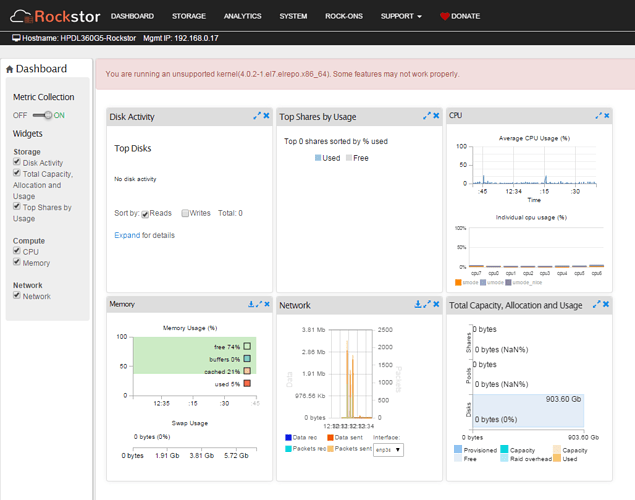I have taken so long in replying that you have already found some of what I am suggesting but posting anyway as I think it may still help; does the “could not boot” error come from the installer or did you get to do an install with you quoted option. Please see my now belated post that may still help:-
OK, my mistake, the install kernel is the standard CentOS 7 3.10 kernel so doesn’t have the cciss but I found a possible way you can use the hspa which is installed (version 3.4.4-1-RH1) in the default install / rescue iso image.
I agree with @suman, since Rockstor is based on Cent OS 7.
In this context others have had success installing Cent OS 7 on your “HP Smart Array P400i” by asking the newer hspa driver to adopt older cards, so the problem does seem to be shared between Rockstor and CentOS7 :-
hpsa.hpsa_allow_any=1
although from https://www.centos.org/forums/viewtopic.php?f=49&t=47011 a poster stated they needed to use:-
hpsa.hpsa_simple_mode=1 hpsa.hpsa_allow_any=1
This is worth a try given there is no cciss driver in the install / rescue iso.
From http://cciss.sourceforge.net/ "The hpsa driver has the ability to claim unknown Smart Arrays, however this is turned off by default so that it does not try to claim older controllers meant to be claimed by the cciss driver. To enable this feature of hpsa, the module parameter hpsa.hpsa_allow_any=1 can be used."
Plus if you get to see your drives during install on the hspa then your drives will appear as normal scsi drive names.
Note that any custom parameter required during install will have to be transferred to the kernel command line controlled by grub as otherwise the installed system will fail to find it’s own drives in the same way the installer failed to find them. @suman 's boot parameter suggestion allows for installing on other than sda as I understand it.
@sirhcjw has a forum post on how he modified Rockstor’s grubs supply of command line arguments to the kernel.
The centos forum link above indicates how they went about this; although you should edit /etc/default/grub instead as in @sirhcjw post.
Rockstor’s iso also has this rescue capability on boot so if you manage to find working parameter during install then you can transfer them to the installed systems /etc/default/grub via the rescue system on the iso as follows:-
Assuming you found working kernel boot options and they were eg:-
hpsa.hpsa_simple_mode=1 hpsa.hpsa_allow_any=1
and you were able to install Rockstor onto sda.
You now need to add the working kernel boot options to the installed system.
This is a bit tricky as the installed system has the alternative older and depricated cciss drivers and it may well have a stab at your controller and that doesnt’ seem like a good idea as we would be installing under one driver and drive name and then booting into another driver and different drive names so given you are in a no loss situation you might be game to just try it but I would avoid the initial boot (ie after the install) by switching the machine off when it gets to bios after the initial install. Then boot using the iso again, or just make sure it boots the iso again directly after install so that the following can be done:-
- Troubleshooting (Enter)
- Rescue a Rockstor system (just highlight this via cursor keys then press the TAB key to bring up the kernel parameter entry at the bottom of the screen).
- enter your magic kernel options found during install at the end of this line (you can remove the quiet entry)
- press Enter key once you have the additional kernel options entered
- You should then end up with a text dialog explaining the Rescue system, select Continue.
- OK on the next dialog explaining the chroot command (which you will need incidentally)
- you should now be in a rescue mode shell
- enter the previously suggested “chroot /mnt/sysimage” so that this shell becomes ‘rooted’ on the installed system
- cat /proc/cmdline (this command should help to verify what command line options the running kernel is using)
- nano /etc/default/grub
- add your magic kernel options to the GRUB_CMDLINE_LINUX= but note the following:-
N.B. The installed kernel of Rockstor has both cciss and hspa so the cciss driver may well take ownership first. To use the same driver as you used during install you will also need to tell the installed kernel’s cciss driver to allow hpsa by adding yet another parameter to your freshly installed systems /etc/default/grub files GRUB_CMDLINE_LINUX= line:-
cciss.cciss_allow_hpsa=1
- so in your case I think the line may well end up something like (I removed the quiet so we get more boot info) should be all on one line though.
GRUB_CMDLINE_LINUX="crashkernel=auto rhgb cciss.cciss_allow_hpsa=1 hpsa.hpsa_simple_mode=1 hpsa.hpsa_allow_any=1 "
- Save the file using the on-screen instructions of nano (Ctrl+O) and exit (Ctrl+X)
- reassert grub using it’s new configuration on the installed system by running “grub2-mkconfig -o /boot/grub2/grub.cfg”
- sync (because I’m old)
- exit (will exit your chroot environment)
- exit (will pop you into a reboot and out of the rescue system but this time hopefully you can boot the installed system)
Hope this helps.

 ) ; so it looks like bar my mistakes we are getting somewhere. If we get this sorted then it can serve as a guide to others on the same hardware which would be great so thanks for being the guinea pig.
) ; so it looks like bar my mistakes we are getting somewhere. If we get this sorted then it can serve as a guide to others on the same hardware which would be great so thanks for being the guinea pig.
